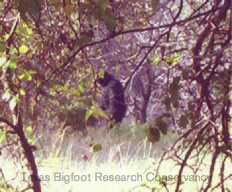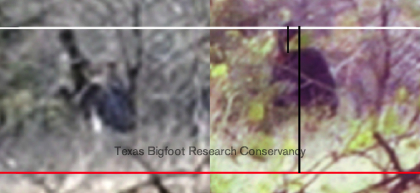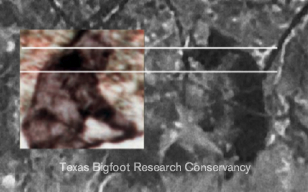Support the TBRC
Possible Wood Ape Photos From Central Oklahoma
By Alton Higgins
The following is an abridged version of an article that has been submitted to The Relic Hominoid Inquiry provisionally entitled “Photographs of a Possible Unrecognized Bipedal Hominoid From Oklahoma.”
Introduction
Oklahoma has a long record of sightings of large apelike creatures resembling what people often refer to as the sasquatch or Bigfoot. Most of these accounts originate in the mountainous eastern areas of the state; however, sightings are also affiliated with locations along or near Oklahoma’s major rivers. One such area with a history of accounts pertaining to mysterious manlike creatures is the Cheyenne and Arapaho tribal trust lands in Canadian County, located west of Oklahoma City.
In November 2000 Russell Lumpmouth, a member of the Arapaho tribe, took two photographs that appear to feature a sasquatch-like figure. According to his account, he and several co-workers were cleaning up after an outdoor tribal function. His supervisor walked over a short distance from their vehicles to pose for a picture with a piece of litter seen lying on the ground. Lumpmouth followed with a borrowed digital camera. As he looked through the viewfinder and took the picture, he noted the appearance of a dark object in the background, visible through gaps in the foliage that aligned from his position. Advancing a step or two out of curiosity, he took a second picture as the subject turned and departed. The men did not initiate a pursuit. The photos were printed on high quality 8×10 photo paper. According to Lumpmouth, the office secretary said the images disturbed her and the files were deleted from the computer. Higgins corroborated this description of events during on-site visits and conversations (Higgins, 2004). Further details regarding area investigations are available online via the “Sasquatch on the Oklahoma Prairie” interview available here (MP3).
Methods
Methods
The prints were copied in February 2001 using a Microtek ScanMaker X6EL scanner and a Power Macintosh 6100/60 AV computer. Parts of the images containing the subject were scanned at 1200 dpi. The key question that arose concerned the possibility of a hoax. Comparison images were obtained about thirteen months after the original photos were taken to help in assessing the relative size of the subject. Of significance for evaluative purposes was the location of the subject behind a distinctive small tree. Photos were taken using a human model positioned near the small tree so as to derive a conservative estimate of the subject’s size. The man in the comparison photo held a 2.3 m (7.5-ft) pole draped with an Army field jacket. This photo was cropped and enlarged to enable side-by-side comparisons with the subject depicted in the original photographs.
One should expect to see similarities in body structure and proportions among members of the same species. Therefore, comparisons were also made to the subject filmed in 1967 by Roger Patterson and Bob Gimlin in northern California, a creature thought by many to be a genuine record of an unrecognized species of bipedal primate (Bayanov, 1997; Krantz, 1999; Meldrum, 2006).
Results
Results
A cropped portion of the first photograph shows the subject facing the camera with the body at about a three-quarter anterior angle (Fig. 1). The face, partially obscured by a foreground leaf, presents what appears to be a deep-set right eye. The lighter area around the socket could represent the presence of a protruding supraorbital ridge, extending to prominent frontal and zygomatic processes. These areas may be relatively hairless producing highlights of the skin in the bright sunlight. The face looks to be tall, relative to the neurocranium, with heavy jaws.

Figure 1. Close-up of a photo taken in central Oklahoma showing a bipedal figure.
The second picture shows the subject from the left side (Fig. 2). The head appears to sit at a very low position, with the chin clearly located well below shoulder height (cf. Krantz, 1999, p. 150). There is a forward lean of the head and upper torso. The facial profile appears to be quite flat, but specific facial characteristics are unresolved. The left arm looks to be thick, and the subject appears to have a powerful barrel-shaped torso. What could be abdominal muscles are visible, possibly indicating sparse or short hair on that part of the body. The buttocks is prominent, a characteristic of habitual bipedal posture in hominins. What looks to be a muscular thigh is partially revealed through the grass.

Figure 2. Close-up view of the second photograph.
In side-by-side comparisons the subject towers over the 1.7 m (68 in) man holding the pole. Extrapolations indicate the possibility of a stature in excess of 2.3 m (7.5 ft). The difference in body mass is substantial. The subject’s massive head appears to be twice the size of the man’s head and represents approximately 18% of its body height (Fig. 3).

Figure 3. Height and head/stature proportional comparisons.
The white line is approximately 2.3 m (7.5 ft) high. The red line approximates ground level where the subjects stood, as determined by the height of the man and the jacket-draped pole. Based on the lengths of the black lines in the image, depicting conservative estimates of head and total body heights (30 and 165 pixels, as initially measured), the subject’s head appears to represent 18.2% of height. This differs significantly from typical human ratios, where the head averages about 13% of height.
The second photo was compared to a frame from the Patterson-Gimlin film. Although the California subject appears to be a female, similarities of posture, proportion and morphology between it and the Oklahoma subject are striking (Fig. 4). The configuration of the head and shoulders appears to correlate with that commonly seen in the great apes.

Figure 4. Head position of the Patterson-Gimlin film subject (inset) compared to the Oklahoma figure.
Conclusion
Any evidence in support of the existence of a species such as the sasquatch must be carefully considered. In the present case, because of the nature of the photos, only two options for interpretation exist: either the photos are a genuine record of a species not previously accepted, or the pictures are a hoax. The behavior of the photographer has not been consistent with what one might expect from a hoaxer, presuming most such individuals are motivated by a desire for attention or profit. If the Oklahoma photo subject represents a person wearing a gorilla suit, it certainly appears that a person of gigantic proportions was recruited to pull off the prank, wearing what surely must have therefore been a customized costume. However, based on morphological similarities between the Oklahoma and California subjects, and the size and proportions of the individual photographed in Oklahoma, it seems most reasonable to posit that the photographic evidence presented here supports the hypothesis that a currently unrecognized hominoid species exists in North America.
Acknowledgments
Acknowledgments
Thanks must be given to Russell Lumpmouth for approving the use of the photographs. Roger Roberts and Brett Elliott assisted with the recreation photos. Special recognition must go to Jeffrey Meldrum for his encouragement and guidance.
References
References
Bayanov, D. (1997). America’s bigfoot: Fact, not fiction. Moscow, Russia: Crypto Logos. 222 p.
Higgins, A. (2004). Evaluating purported sasquatch photographic evidence. Bigfoot Information Project.
Krantz, G. S. (1999). Bigfoot sasquatch evidence. Blaine, WA: Hancock House. 348 p.
Meldrum, D. J. (2006). Sasquatch: Legend meets science. New York, NY: Forge–Dougherty Associates. 320 p.



what I find extremely interestingis that clearly visible Brow ridgein the side on photographs..
ReplyDelete